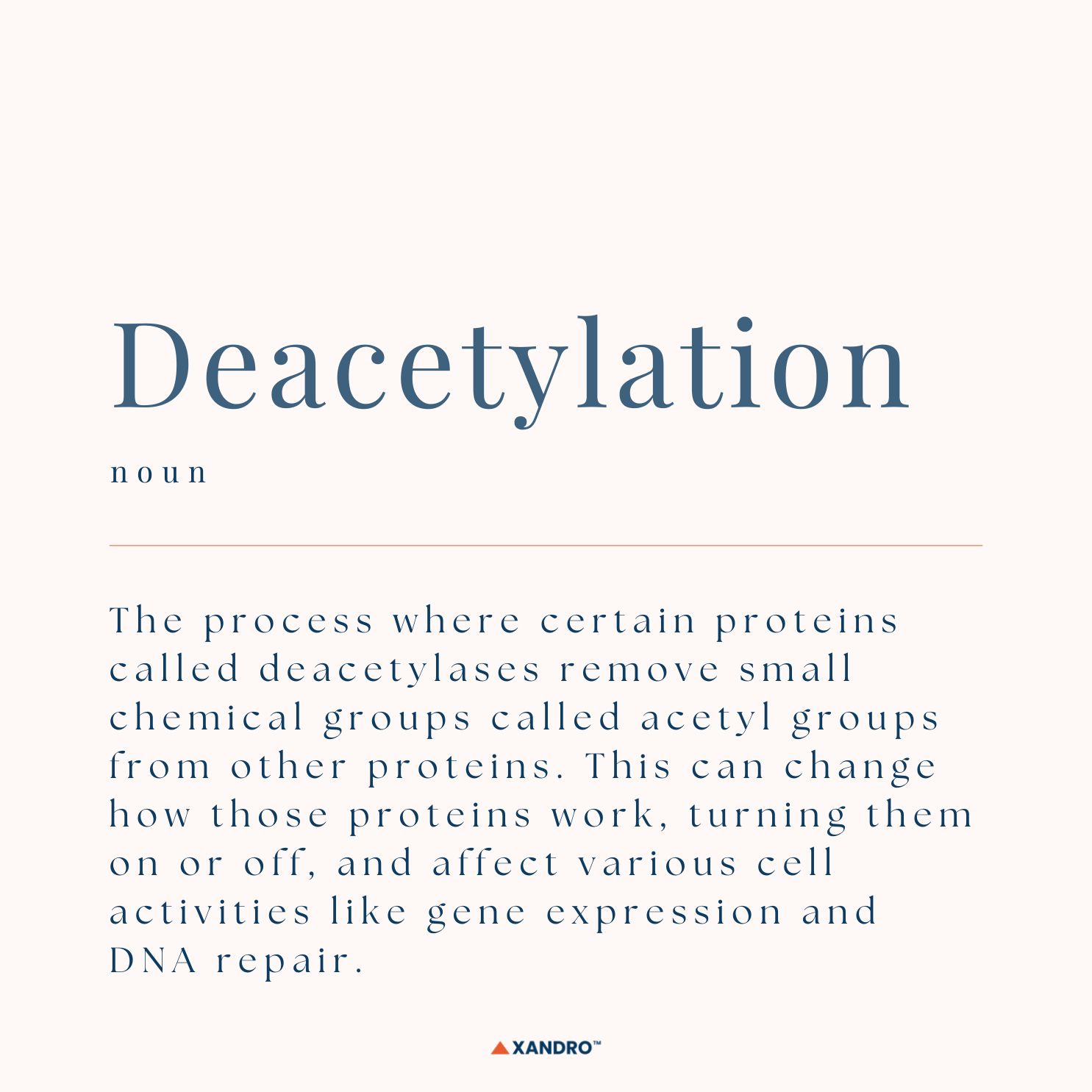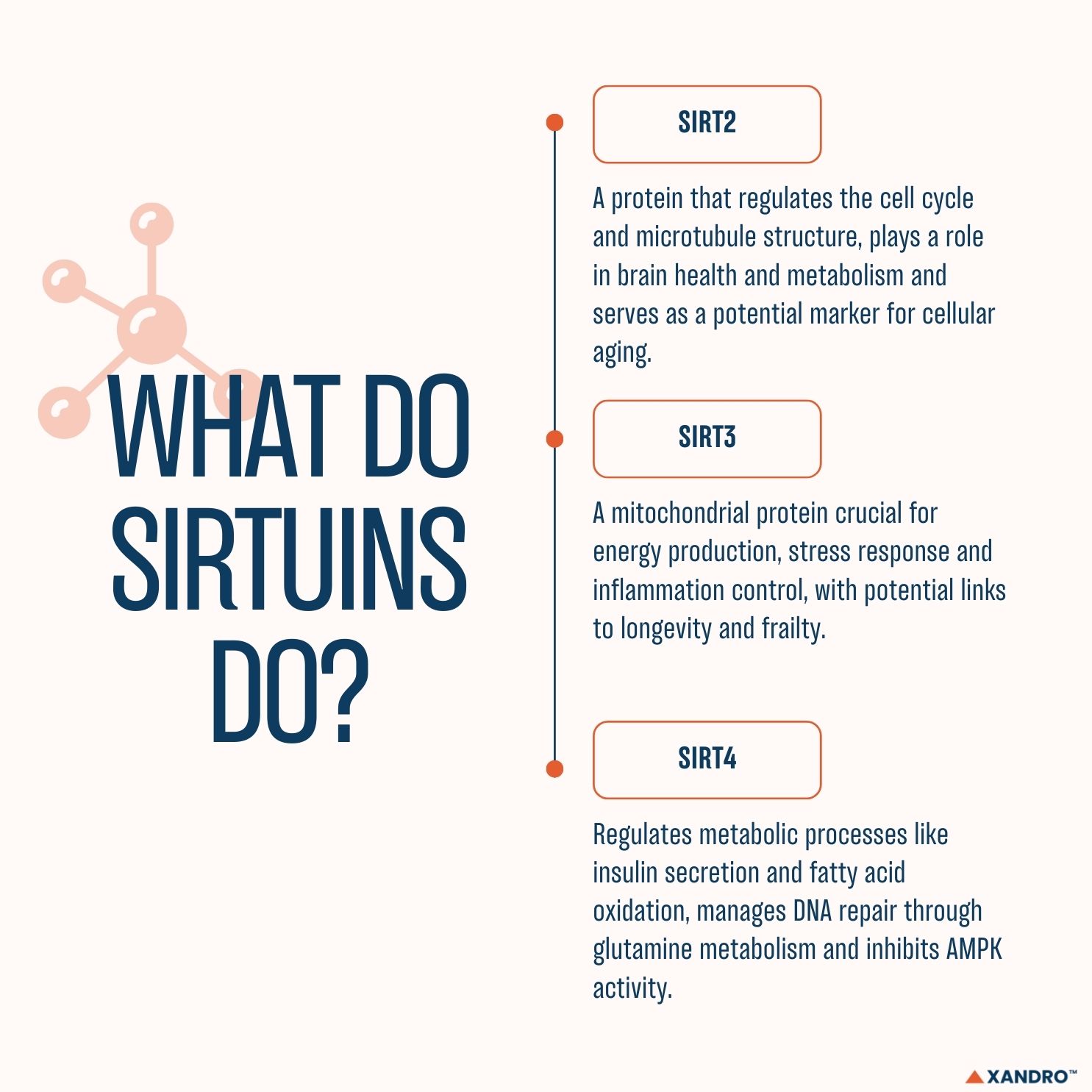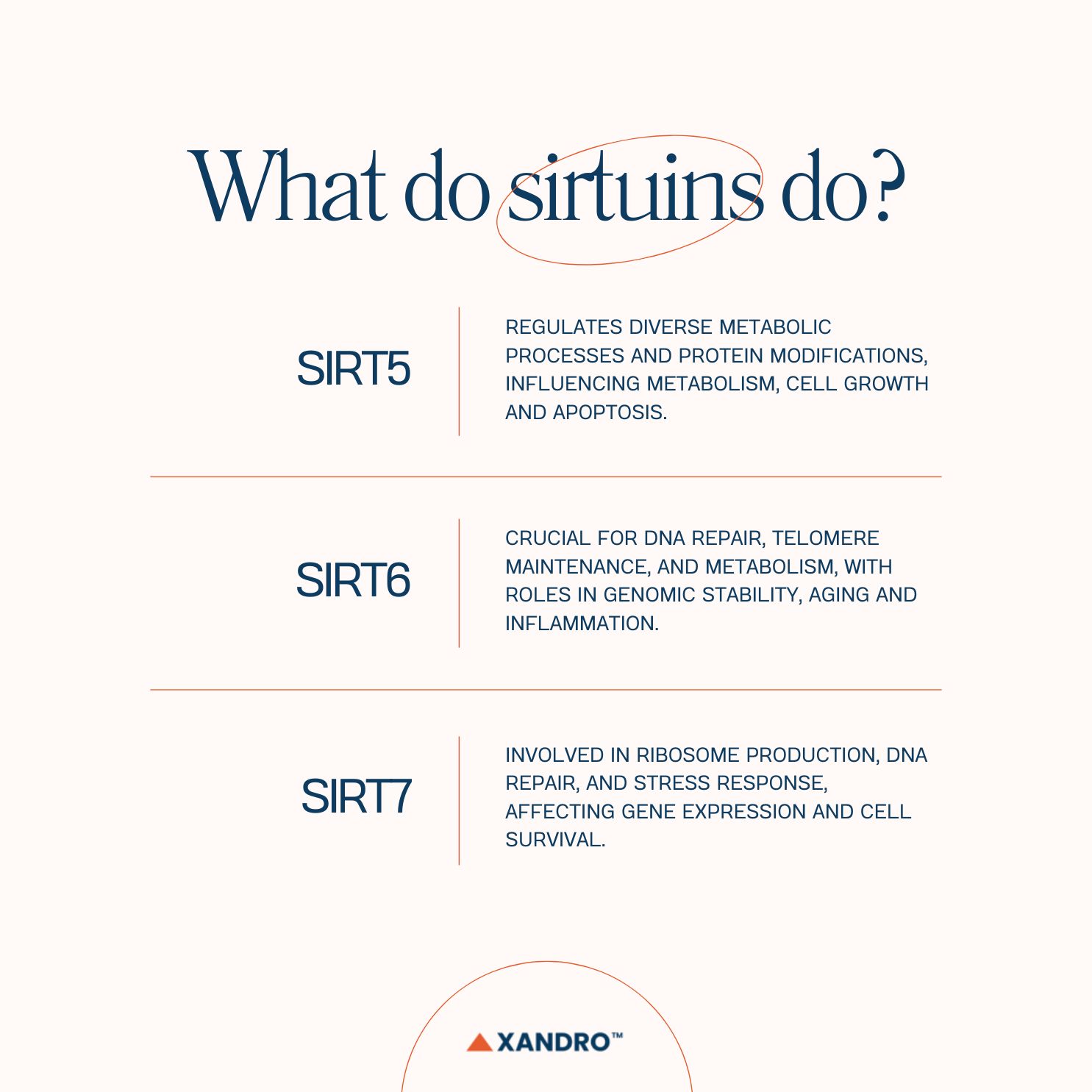The Function of Sirtuins and Sirtuin Activators
3rd Aug 2024
What Are Sirtuins: Everything You Need to Know
Jump there now:
- What Are Sirtuins and What Do They Do?
- What Are The 7 Sirtuins and Where Are Sirtuins Found?
- What Are Sirtuin Inhibitors?
- End Note
Sirtuins are proteins that help control aging, metabolism and how cells respond to stress. They are NAD+-dependent deacetylases (although sirtuins are now known as a general term: deacylases), meaning they needNAD+ to work.
There are seven types of sirtuins in humans, known as SIRT1–7. Sirtuins function by having an important role in cell functions like DNA repair, gene control, apoptosis, neuroprotection, development, immune response and keeping mitochondria (the cell's energy producers) healthy. Each sirtuin consists of 275 amino acids!
While it's not certain that sirtuins directly extend the human lifespan, having a healthy lifestyle with exercise and a good diet can boost sirtuin levels and improve health. Scientists are actively searching for ways to activate sirtuins to harness their benefits.
Sirtuins benefits vary but in terms of sirtuins and aging, it was found that SIRT2 overexpression could extend yeast lifespan by up to 70 per cent, but this differs in humans due to how complex human stem cells and aging is.
If interested, you can head straight to our article about how to activate sirtuins here.
So, what are sirtuins in humans? As mentioned, in mammals, seven enzymes belong to the sirtuin family and these each have different functions and are located in different places.
Location: Nucleus and cytoplasm
Function:
SIRT1 is the most studied sirtuin and plays a key role in foetal development and controlling inflammation, metabolism and aging. In mice, a lack of SIRT1 leads to severe developmental issues and early death. As mice age, their SIRT1 levels drop, which is linked to increased DNA damage and aging, especially in the liver and cardiovascular system.
Further Reading: Is Calcium AKG Good for My Heart?
Having extra copies of the SIRT1 gene in mice reduces DNA damage and signs of aging. Increasing SIRT1 in heart cells helps recover from heart attacks. Some genetic variations in SIRT1 can affect body weight and obesity but do not seem to extend lifespan.
SIRT1 helps delay cell aging and senescence, especially under stress. In stressed cells, a decrease in SIRT1 leads to more cell death. SIRT1 levels drop in tissues as they age, which affects cell health and function.
It also works by deacetylates various proteins, like p53 (which helps prevent cancer), NF-κB (which is involved in inflammation) and FOXO (which is linked to longer life and stress resistance).
SIRT1 is important in aging and various diseases, including heart disease, neurodegeneration, diabetes and cancer, so increasing SIRT1 activity could be beneficial for longevity and health.
Definition: Deacetylation is a process where certain proteins called deacetylases remove small chemical groups called acetyl groups from other proteins. This can change how those proteins work, turning them on or off, and affect various cell activities like gene expression and DNA repair.
Potential SIRT1 Activators:
- Resveratrol: Directly activates SIRT1, mimicking the effects of caloric restriction.
- SRT1720, SRT2104, SRT2379: May activate SIRT1 in mice, but more studies are needed.
- Caloric Restriction: Increases NAD+ levels, which in turn activates SIRT1.
- NAD+ Precursors (e.g., Nicotinamide Riboside (NR) and Nicotinamide Mononucleotide (NMN)): Boost NAD+ levels, thereby activating SIRT1 and other NAD+-dependent enzymes.
- Curcumin: Has been found to activate SIRT1 and AMPK.
- Berberine: Alone or combined with resveratrol may activate SIRT1.
- Fisetin: Enhances SIRT1 expression.

Location: Cytoplasm and nucleus
Function:
SIRT2 is a protein mostly found in the cell's cytoplasm but also in the nucleus — it moves to the nucleus during certain phases of the cell cycle to help with DNA and chromosome organisation. It helps control the cell cycle, the structure of cell parts like microtubules and cell division (mitosis). SIRT2 is important for brain health and metabolism as it deacetylates α-tubulin and other proteins.
In obese people, SIRT2 levels drop in fat tissue, but it was found that in mice on a calorie-restricted diet, SIRT2 levels go up in fat tissue and kidneys. SIRT2 levels rise in aging cells, making it a potential marker for cellular aging, although, this increase is likely a result of aging, not a cause.
Further Reading: Best Supplements for Weight Loss
Location: Mitochondria
Function:
SIRT3 is a key protein in the mitochondria that helps regulate energy production and keep mitochondria functioning well, especially during stress. It activates important enzymes involved in energy processes like the TCA cycle, fatty acid breakdown and the electron transport chain. SIRT3 moves from the nucleus to the mitochondria during stress.
Studies suggest SIRT3 might influence human longevity. A certain genetic variation in SIRT3 is more common in long-lived people, although other research shows its impact on lifespan might be small.
In mice, a lack of SIRT3 leads to less oxygen use, more harmful reactive oxygen species (ROS) and higher oxidative stress in muscles. Also, one of SIRT3's main functions is that it helps reduce inflammation by affecting immune cell responses and lowering inflammatory markers.
SIRT3, along with SIRT1 and SIRT2, plays a role in aging and fertility. Lower levels of these proteins are linked to aging in oocytes (egg cells), while higher levels protect against aging effects.
SIRT3 could also be a marker for frailty, a condition in older people characterized by weakness and declining health. Lower SIRT1 and SIRT3 levels in the blood are associated with frailty, suggesting it could help in early diagnosis.
Potential SIRT3 Activators:
- Caloric Restriction: Increases NAD+ levels, activating SIRT3 in mitochondria.
- Exercise: Increases NAD+ levels and activates SIRT3.
- Intermittent Fasting: Increases NAD+ levels, activating multiple sirtuins including SIRT3, SIRT4 and SIRT5.
- NAD+ Precursors like NMN
Location: Mitochondria
Function:
SIRT4 is a protein involved in regulating various metabolic processes, including insulin secretion, fatty acid oxidation and responses to caloric restriction (it’s actually the only sirtuin that doesn’t increase in response to calorie restriction). It has both ADP-ribosylation and deacetylase activities, impacting how cells handle nutrients and energy.
One of SIRT4's key roles is in managing DNA damage by influencing mitochondrial metabolism. It regulates glutamine metabolism, crucial for DNA repair, by inhibiting the enzyme glutamate dehydrogenase and blocking the transport of intermediates needed for the Krebs cycle. This helps prioritise the production of purine nucleotides necessary for repairing DNA. When SIRT4 levels are low, DNA repair is compromised, leading to increased DNA damage. On the other hand, higher levels of SIRT4 support better DNA repair.
SIRT4 also inhibits AMPK activity, which plays a role in energy balance and metabolism. Also, while SIRT3 and SIRT4 both affect glutamine metabolism, they do so in different ways. SIRT3 loss leads to increased glutamine use in nucleotide production, while SIRT4 inhibits glutamine metabolism in cancer cells, acting as a potential tumour suppressor.

Further Reading: Everything to Know About Your Digestive Health
Location: Mitochondria
Function:
SIRT5 is a versatile protein that helps manage various metabolic processes in the body. It can remove different chemical modifications from proteins, such as malonylation and succinylation. This regulation impacts important metabolic functions like the urea cycle, fatty acid oxidation and ketone production. SIRT5 also affects key enzymes involved in these processes, helping maintain metabolic balance.
In addition to its metabolic roles, SIRT5 influences cell growth and apoptosis (programmed cell death). It regulates apoptosis by modifying proteins like cytochrome c, which is crucial for cell survival and death. Overexpression of SIRT5 can help prevent excessive cell death, offering potential benefits for treating diseases related to apoptosis.
SIRT5's effects on cell proliferation are complex. It can promote the growth of cancer cells by activating certain signalling pathways but also suppress the proliferation of pancreatic β-cells, which are important for insulin production. This dual role in cell growth suggests that SIRT5’s impact varies depending on the cell type and context, and more research is needed.
Potential SIRT5 Activators:
- Curcumin: Levels of SIRT5 may increase after curcumin treatment.
- NAD+ Precursors like NMN
Location: Nucleus
Function:
SIRT6 is a key protein involved in DNA repair, maintaining telomeres and regulating glucose and fat (lipid) metabolism. It affects gene expression and the structure of chromatin by deacetylating certain proteins. Essential for genomic stability, SIRT6 is linked to longevity and also participates in ADP-ribosylation, like SIRT4.
Research on mice without SIRT6 showed severe signs of premature aging and degeneration, including fat loss, bone issues and severe metabolic problems, leading to death within four weeks. These mice had low levels of IGF-1 and glucose, with hypoglycemia due to increased glucose uptake as the primary cause of death. On the other hand, mice with higher levels of SIRT6 lived longer, had better glucose tolerance and accumulated less fat.
Cells lacking SIRT6 show reduced growth and increased genomic instability, making them more susceptible to stress. In humans, SIRT6 levels decrease with age in various cells, contributing to aging-related issues.
SIRT6 also has anti-inflammatory properties. It reduces inflammation by repressing NF-κB activity, which is linked to chronic inflammation. Overexpression of SIRT6 can further suppress inflammation.
Potential SIRT6 Activators:
- Fisetin: Activates SIRT6, though the exact mechanism is still being studied.
- Quercetin: Activates SIRT6 and may also increase its expression.
- Exercise: Exercise can enhance SIRT6 activity, improving insulin sensitivity in the liver and muscles, highlighting its potential role in managing glucose metabolism.
- NAD+ Precursors like NMN
Location: Nucleus
Function:
SIRT7 is a protein that plays a crucial role in ribosome production, DNA repair and stress resistance. It influences gene expression and chromatin structure by deacetylating histone H3. Additionally, SIRT7 is essential for regulating rDNA transcription and nucleolar activity.
Mice lacking SIRT7 age prematurely and suffer from severe heart problems, leading to ea rly death. During cell aging (replicative senescence), SIRT7 moves from the nucleoli to the chromatin and cytoplasm, reducing rDNA transcription.
SIRT7 also helps control apoptosis by regulating proteins like p53, promoting cell survival under stress by reducing DNA damage and the p53 response. Its role in autophagy, a process that removes damaged cells, needs more research, but some studies suggest that SIRT7 helps protect cells from degeneration and promotes autophagy in certain cancer cells, indicating a potential role in tumour growth and spread.
Further Reading: All About STACs and Sirtuin Activation
Sirtuin inhibitors target various sirtuin proteins, which are involved in regulating important cellular processes. These inhibitors have potential uses in treating several conditions.
For instance, blocking SIRT1 might help in treating cancer (as SIRT1 is often overactive in cancer cells), certain viral infections and genetic disorders like Fragile X syndrome and Parkinson’s disease. It could also be useful for preventing parasitic diseases. SIRT2 inhibitors are being explored for their potential to treat cancer and neurodegenerative diseases.
SIRT3, SIRT4, and SIRT5 are found in mitochondria and are important for energy metabolism and cell death processes. Their inhibition could be relevant in managing diseases like metabolic syndrome and cancer.
Overall, sirtuin inhibitors offer promising avenues for therapy in various diseases, although more research is needed to fully understand their potential benefits and applications.
So, how can I boost my sirtuins?
We have a whole article talking about sirtuin-activating compounds (STACs), but some sirtuins supplements include resveratrol, curcumin, NMN and berberine. It also talks about sirtuins foods, the sirtuin diet and sirtuins and fasting.
Remember that NAD+ and, therefore, NMN, is required for sirtuins to work, so consider taking Xandro’s Pure NMN Powder or Pure NMN Capsules to help activate your sirtuins.
Keep in mind that research around sirtuin activators is still underway, so while there is research and some proof surrounding sirtuins and resveratrol and quercetin sirtuin benefits, for example, more human studies are needed.
While these interventions may have significant health benefits and may help you in your healthy aging and longevity goals, make sure you have a chat with your doctor before starting any new dietary or supplement regimen.
